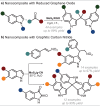Molybdenum Disulfide-Based Catalysts in Organic Synthesis: State of the Art, Open Issues, and Future Perspectives
- PMID: 39428828
- PMCID: PMC11673405
- DOI: 10.1002/smll.202406697
Molybdenum Disulfide-Based Catalysts in Organic Synthesis: State of the Art, Open Issues, and Future Perspectives
Abstract
In the field of heterogeneous organic catalysis, molybdenum disulfide (MoS2) is gaining increasing attention as a catalytically active material due to its low toxicity, earth abundance, and affordability. Interestingly, the catalytic properties of this metal-based material can be improved by several strategies. In this Perspective, through the analysis of some explicative examples, the main approaches used to prepare highly efficient MoS2-based catalysts in relevant organic reactions are summarized and critically discussed, namely: i) increment of the specific surface area, ii) generation of the metallic 1T phase, iii) introduction of vacancies, iv) preparation of nanostructured hybrids/composites, v) doping with transition metal ions, and vi) partial oxidation of MoS2. Finally, emerging trends in MoS2-based materials catalysis leading to a richer organic synthesis are presented.
Keywords: heterogenous catalysis; molybdenum disulfide; organic chemistry.
© 2024 The Author(s). Small published by Wiley‐VCH GmbH.
Conflict of interest statement
The authors declare no conflict of interest.
Figures





References
-
- Novoselov K. S., Mishchenko A., Carvalho A., Castro Neto A. H., Science 2016, 353, aac9439. - PubMed
-
- a) Wilson J. A., Yoffe A. D., Adv. Phys. 1969, 18, 193.
- b) Ippolito S., Ciesielski A., Samorì P., Chem. Commun. 2019, 55, 8900. - PubMed
-
- Zhang Q., Mei L., Cao X., Tang Y., Zeng Z., J. Mater. Chem. A. 2020, 8, 15417.
-
- Chhowalla M., Shin H. S., Eda G., Li L.‐J., Loh K. P., Zhang H., Nat. Chem. 2013, 5, 263. - PubMed
-
- Song I., Park C., Choi H. C., RSC Adv. 2015, 5, 7495.
Grants and funding
LinkOut - more resources
Full Text Sources

